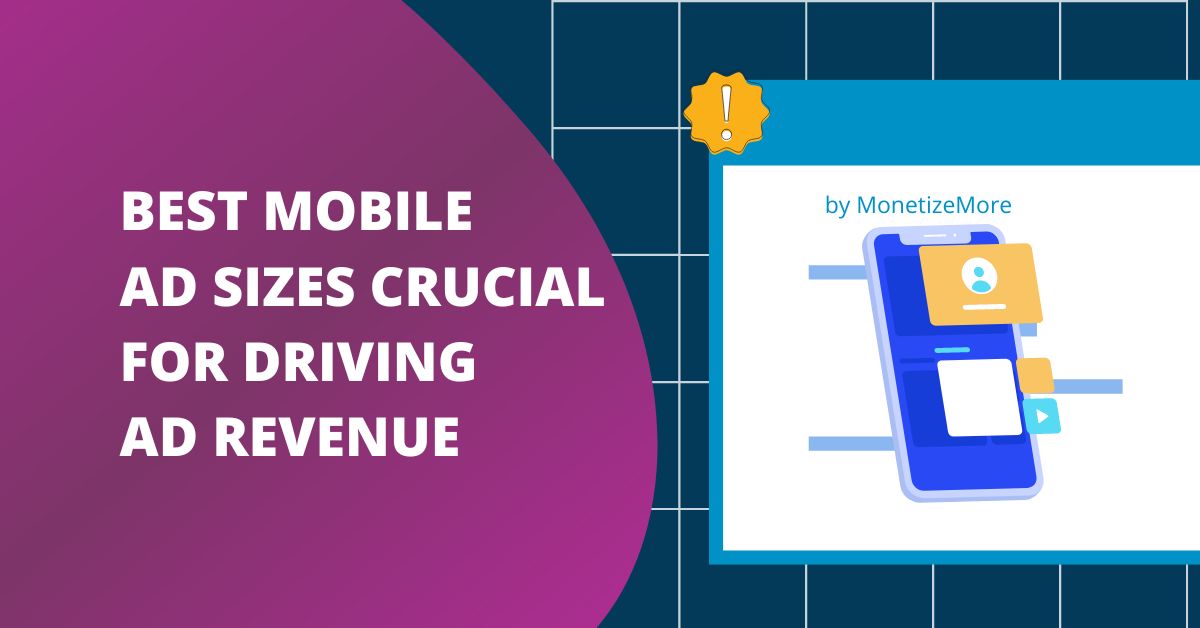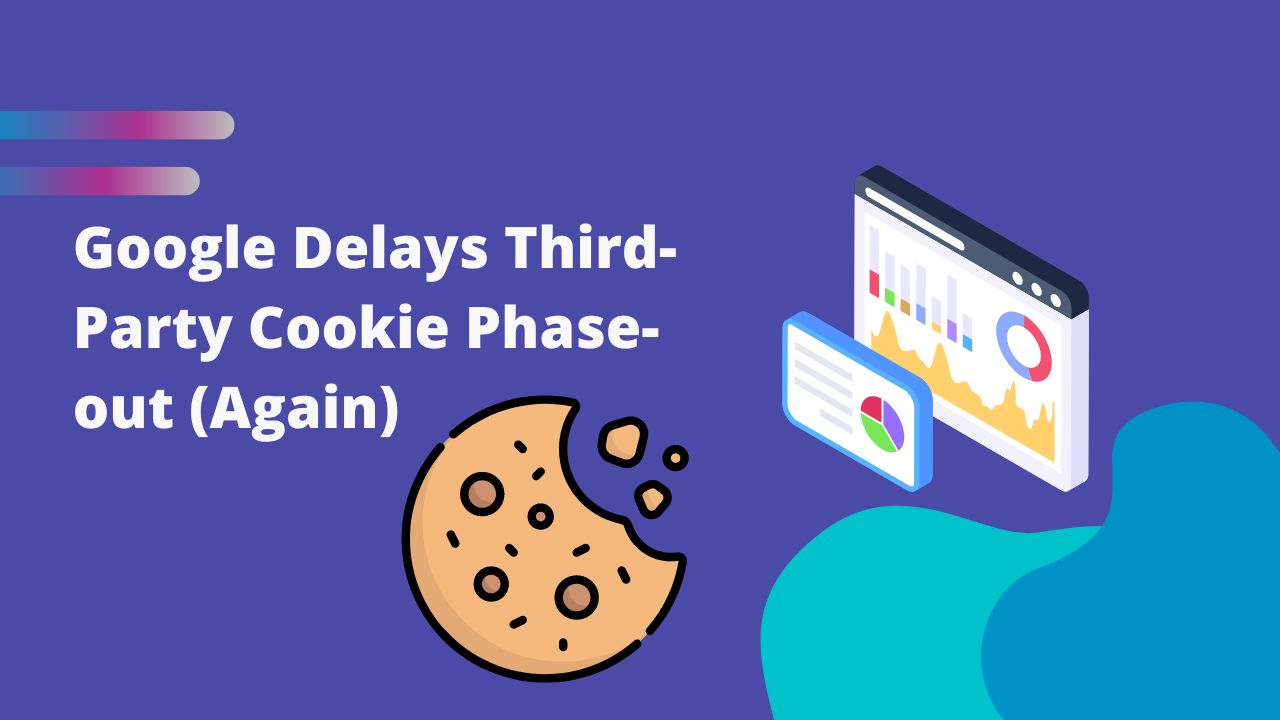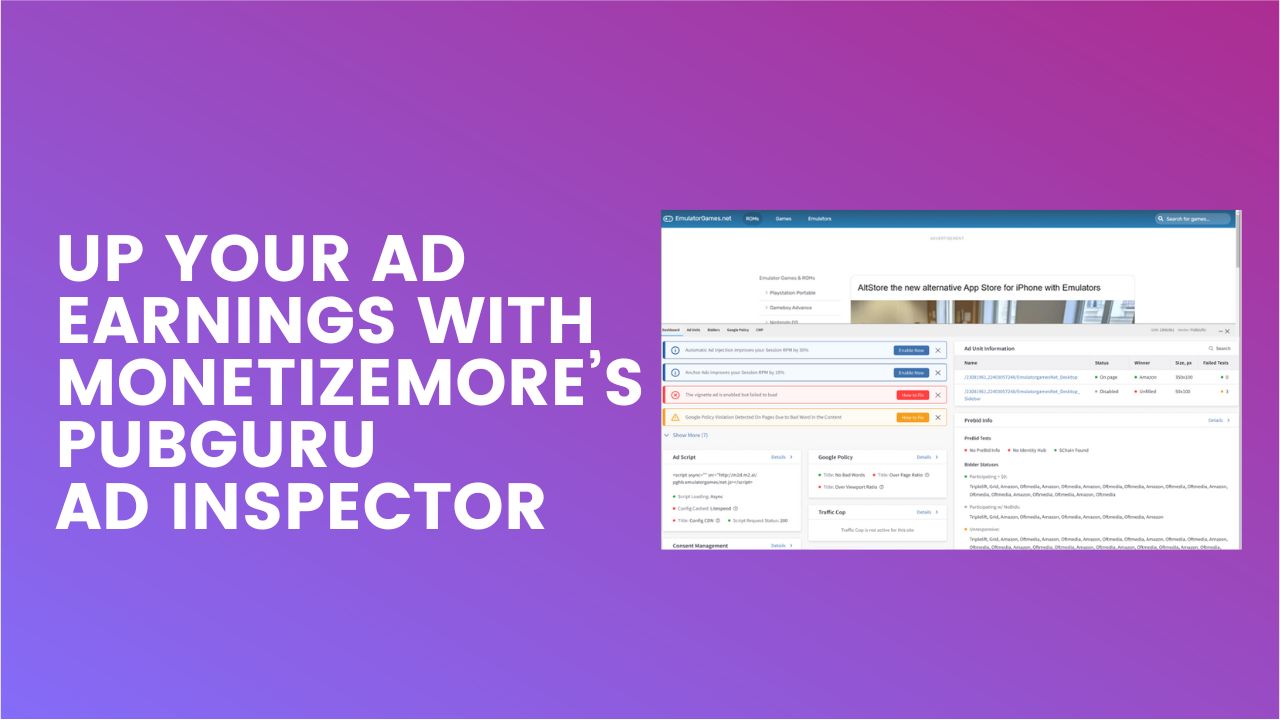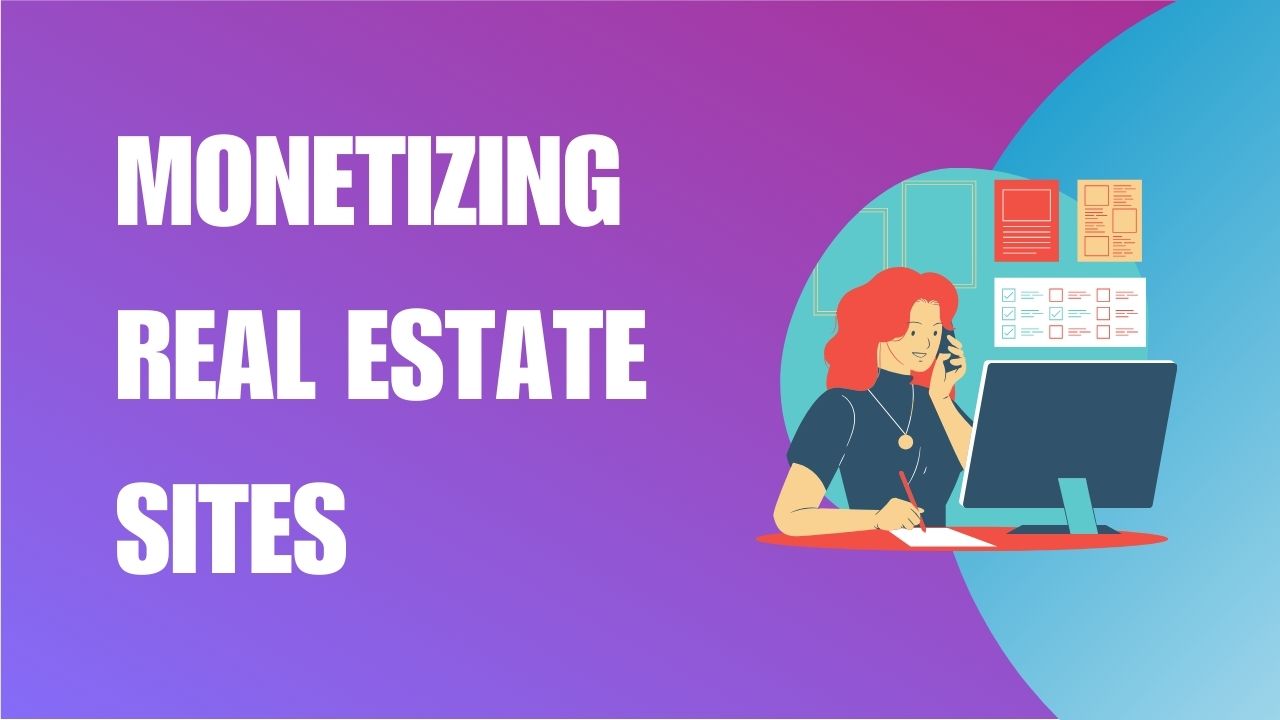
With an estimated 7 billion mobile users on the planet, engagement with mobile devices is higher than ever and continuously growing.
People of all ages, generations, and genders are using their devices wherever they go, some even for hours per day. These users get bombarded by messages, news events, and social media daily – all very distracting.
This increases the need for mobile ads to be attention-grabbing, and placed in optimal digital spots for maximum viewability while utilizing the best banner sizes for maximum revenue generation for publishers and successful campaign management for advertisers.
Let’s take a look at some of the best mobile ad sizes for publishers in 2024 and optimization tips you can start implementing today:
|
Running into costly errors with mobile ad ops? It’s overwhelming to learn the various techniques to start winning with mobile ads. That’s where we can help. Partner with MonetizeMore today to take on the mobile web and start increasing your mobile ad revenue today! |
Since the last 5 years, when Google changed their mobile ad types policies and removed restrictions to place 300×250 units above the fold, this medium rectangle has been the most used banner size. It works very well on both desktop and mobile, which is one of the main reasons for its popularity.
It also performs very well because it is usually embedded within the content of the website. The image below demonstrates viewability compared to the ad placement of the 300×250 unit.
![Best Mobile Ad Sizes to implement in 2024 [Don't miss out] MonitizeMore Best Mobile Ad Sizes to implement in 2024 [Don't miss out] MonitizeMore](https://www.monetizemore.com/wp-content/uploads/2014/10/google-small-banner-unit-fixed.jpg)
Buyers tend to favor this placement as it is the first thing users see on a mobile site’s landing page. Compared to the small banner sizes (e.g., 320×50), bigger mobile display ad sizes (e.g., 300×250) usually generate better revenues.
However, being too aggressive with your ad placements can increase the chances of accidental clicks and lead to negative user experiences. As a publisher reliant on one of Google’s networks for monetization, whether it’s Ad Exchange or AdSense, you don’t want to risk getting your account banned.
For this reason, it’s best to follow Google recommendations and only have 50% of the ad viewable above the fold. The image below provides excellent examples of successful 300×250 as well as 300×50 mobile ad specs and placements.
![Best Mobile Ad Sizes to implement in 2024 [Don't miss out] MonitizeMore Best Mobile Ad Sizes to implement in 2024 [Don't miss out] MonitizeMore](https://www.monetizemore.com/wp-content/uploads/2014/10/google-sizes.jpg)
With its 16:9 aspect ratio, one of the most preferred for video ads, this format guarantees optimal viewing on mobile screens. You can benefit from uploading higher resolutions like 640×480, 640×360, or 1920×1080, as advanced ad platforms like GAM intelligently transcode these into the mobile-friendly 320×180 size. This process ensures that your video content is displayed crisply and effectively across various mobile devices and apps, making the 320×180 video ad a solid format for impactful mobile advertising.
![Best Mobile Ad Sizes to implement in 2024 [Don't miss out] MonitizeMore Best Mobile Ad Sizes to implement in 2024 [Don't miss out] MonitizeMore](https://www.monetizemore.com/wp-content/uploads/2022/11/320×180-video-instream-ad-585x1024.webp)
![Best Mobile Ad Sizes to implement in 2024 [Don't miss out] MonitizeMore Best Mobile Ad Sizes to implement in 2024 [Don't miss out] MonitizeMore](https://www.monetizemore.com/wp-content/uploads/2022/11/336X280-mobile-ad-unit-585x1024.webp)
This powerhouse ad size continues to be a staple in the arsenal of leading Supply-Side Platforms (SSPs) such as Google AdX, Magnite, etc. Its dimensions offer a visually appealing and attention-grabbing canvas, ideal for high-impact messaging and creative designs. The size is large enough to make a statement yet compact enough to integrate seamlessly into various webpage layouts, enhancing user experience without overwhelming content.
Often compared to the 300×250 Medium Rectangle, the 336×280 Large Rectangle provides a slightly larger space, allowing for more creative freedom and a potentially higher engagement rate.
![Best Mobile Ad Sizes to implement in 2024 [Don't miss out] MonitizeMore Best Mobile Ad Sizes to implement in 2024 [Don't miss out] MonitizeMore](https://www.monetizemore.com/wp-content/uploads/2022/11/320X100-585x1024.webp)
Though modest in size, the 320×100 large mobile leaderboard doubles the height of the conventional mobile leaderboard, offering a more substantial space for advertisers to convey their message. This increased height not only enhances the visual appeal but also contributes to a higher viewability rate, making it a preferred choice for mobile campaigns.
Like its smaller counterpart, the 320×100 large mobile leaderboard is celebrated for its exceptional viewability. This means ads in this format are more likely to be seen and engaged with by the target audience, making it an invaluable tool for advertisers aiming to increase brand visibility and user interaction on mobile platforms.
![Best Mobile Ad Sizes to implement in 2024 [Don't miss out] MonitizeMore Best Mobile Ad Sizes to implement in 2024 [Don't miss out] MonitizeMore](https://www.monetizemore.com/wp-content/uploads/2022/11/320X50-585x1024.webp)
The 320×50 size is a standard ad size recognized by the Interactive Advertising Bureau (IAB). This standardization means it’s widely supported and easily integrated across various mobile platforms and networks, ensuring compatibility and ease of use for publishers. This ad size is perfectly suited for mobile screens. It fits naturally across the top or bottom of a mobile device’s screen, providing a seamless viewing experience without disrupting the user’s interaction with the website or app content.
The leaderboard format is highly visible without being obtrusive. This balance is crucial in mobile environments where screen real estate is limited. Its prominence on the screen can lead to higher engagement rates as it captures the user’s attention effectively.
Compared to larger mobile ad formats, the 320×50 is less intrusive. This characteristic is crucial in retaining user engagement and maintaining a positive user experience, as overly aggressive or large ads can lead to negative perceptions or even ad blocking.
![Best Mobile Ad Sizes to implement in 2024 [Don't miss out] MonitizeMore Best Mobile Ad Sizes to implement in 2024 [Don't miss out] MonitizeMore](https://www.monetizemore.com/wp-content/uploads/2022/11/336X336-585x1024.webp)
The 336×336 square mobile ad format is a highly effective tool for boosting app ad revenue, particularly due to its balanced and eye-catching size. This square format provides a substantial visual space, allowing for more creative and engaging ad content that can capture users’ attention more effectively than traditional, smaller mobile ad formats. Its dimensions are ideally suited for both image-based and video content, enabling advertisers to create more immersive and interactive ad experiences. This level of engagement is crucial for driving higher click-through rates, which directly translates into increased ad revenue for apps.
![Best Mobile Ad Sizes to implement in 2024 [Don't miss out] MonitizeMore Best Mobile Ad Sizes to implement in 2024 [Don't miss out] MonitizeMore](https://www.monetizemore.com/wp-content/uploads/2022/11/360X300-585x1024.webp)
This ad size has established itself as a cornerstone in the publisher’s toolkit, renowned for delivering superior results across various platforms. Its secret lies in its unique dimension, which seamlessly adapts to both mobile and desktop environments, ensuring consistent visibility and engagement regardless of the device.
Its adaptability means that the ad can maintain high visibility and impact, whether it’s displayed on a compact mobile screen or a larger desktop monitor. This universal compatibility is a key driver in attracting a wider audience, leading to higher click-through rates and enhanced engagement.
![Best Mobile Ad Sizes to implement in 2024 [Don't miss out] MonitizeMore Best Mobile Ad Sizes to implement in 2024 [Don't miss out] MonitizeMore](https://www.monetizemore.com/wp-content/uploads/2022/11/360X120.png)
The 360×120 dimensions make it an ideal fit for mobile screens. This size is large enough to be noticeable and effective in conveying an advertiser’s message, yet it’s compact enough to not disrupt the overall user experience. The balance between visibility and non-intrusiveness is key in mobile advertising, and the 360×120 mobile leaderboard strikes this balance perfectly.
Thanks to its strategic size and placement, typically at the top or bottom of the mobile screen, this ad unit boasts high viewability. Ads that are easily seen without scrolling often experience higher engagement and click-through rates, which is crucial for the success of any digital campaign.
In the mobile context, where screen space is limited, the efficient use of space is critical. The 360×120 leaderboard uses the available screen real estate wisely, providing an effective advertising space without overwhelming the content or the user.
Larger advertising formats (e.g., mobile interstitial ad sizes) have been proven to be better at capturing the user’s attention and paying the best CPM rates, but publishers should be careful with intrusive ad formats in 2024 on both mobile and desktop versions of their sites.
There’s a non-stop search for creative ways to deliver ads on mobile, thus the birth of these large ad formats which up to now, continues to grow.
In a recent study from Adpiler, 320×50 mobile ad size was found to be the most popular ad size for mobile. 27% of all ad impressions is this medium banner. Although small, it works very well as an Anchor Ad.
The formats 320×50, 300×50, and 300×100 are to become more popular in 2024. But don’t forget the value of the 300×250 banner for your mobile coverage.
![Best Mobile Ad Sizes to implement in 2024 [Don't miss out] MonitizeMore Best Mobile Ad Sizes to implement in 2024 [Don't miss out] MonitizeMore](https://www.monetizemore.com/wp-content/uploads/2019/01/mobile-banner-size.jpg)
Mobile banner ads are omnipresent on the mobile web, and you’ve likely seen them in your app, too. They’re not going anywhere anytime soon, so it’s important to understand how they work, how they can fit into your marketing strategy, and how to avoid common pitfalls.
One of the most important things to keep in mind about mobile banner ads is that, just like their desktop counterparts, they’re only effective if you make sure the user notices them! This means putting them in the right place at the right time. An ad that shows up at prime time won’t do any good if your user is already paying attention to something else on their screen, such as a game or an email.
When it comes to choosing the perfect spot for the mobile banner ad on your website, you must be careful. You don’t want to put it in an area your readers are likely to skip over—on the bottom of a page or after the last article on the page—because they’re likely to not notice it there. Instead, put it in a highly visible spot that people are sure to see as they scroll down your page. This way, even if they don’t click on it right away, they’ll remember seeing it later and will probably visit your site again because they’re curious to see what’s under that ad.
Pros:
Cons:
Mobile native ads that come with the ‘promoted/recommended or suggested’ tag are preferred by many publishers since they are non-intrusive and is not supposed to look sales-oriented. These ads work well for publishers with high pageviews.
They blend well with the content theme and style, so users are not annoyed by these types of mobile ads. Combine them with rewarded ads and interstitial ads for the best results.
Pros:
Cons:
Ever seen those rich media or video ads on Snapchat that cover the whole screen either annoying the viewer or embarking their interest in the ad? These extreme ads are interstitials and are usually placed between story or game transitions. Other than that, these ads have high viewability and have the potential to attract higher CTRs if placed the right way.
Users may find these ads intrusive, so taking care of Interstitial ads when displaying them is crucial:
Understand how to implement them here:
![Best Mobile Ad Sizes to implement in 2024 [Don't miss out] MonitizeMore Best Mobile Ad Sizes to implement in 2024 [Don't miss out] MonitizeMore](https://www.monetizemore.com/wp-content/uploads/2014/10/ux-design.jpg)
1) The mobile banner 320×50 is best implemented as a docked/anchor unit. That’s when it performs better regarding CTR. Since it’s a small ad unit, when served as a regular banner, 300×250 and 320×100 units usually outperform it.
2) “Scroller,” an emerging ad unit that fills the screen without covering the entire content is one approach to ad-blocking concerns. According to the IAB’s report, this type of ad format is non-invasive (the users can scroll past them) and has outperformed expandable banners regarding creativity and enjoyment.
3) Medium Rectangle (300×250) remains to be the best performing banner size. Take advantage of the opportunity to implement it above the fold.
4) In-banner Video (IBV) providers favor 300×250 most of the time. They usually pay the best CPMs which you can compete against Header Bidding to push performance up. When running IBV, try to limit it to two units at most to avoid slowing down the page.
Be careful not to overwhelm your users with too many interstitials per user session. It may turn them off, and they may avoid your site altogether in the future. Should you decide to try interstitials or other intrusive ads, remember the guidelines in the Ad Experience Report.
5) The “Large Rectangle” (336×280) is also a top-performing ad size as suggested by Google. Make your ad unit flexi by adding it along with your standard mobile ad sizes (e.g., 300×250 / 336×280). It has been proven to perform well when embedded within text content or at the end of articles.
6) Aside from the ad size, one advantageous feature of mobile devices is the location service plus. This makes advertising more relevant to users and potentially generate higher clicks. If you are using an ad server, like Google Ad Manager, geographical targeting will play a significant role. Most ad networks can specify the countries where they have campaigns available.
7) Check your ads for aesthetics. Keep only those ad networks that serve high definition quality creatives and ditch the pixelated ones regardless of the CPMs they promise. You can’t afford to compromise on user experience. Ads that are non-pixelated tend to yield positive engagement rates and leave a positive impression on users.
8) You can have multiple ad sizes compete in the same ad spot to tighten competition. For instance, you can have a 300×250 spot serve 320×100 and 320×50. When this happens, the smaller advertisements will always align vertically at the top.
![Best Mobile Ad Sizes to implement in 2024 [Don't miss out] MonitizeMore Best Mobile Ad Sizes to implement in 2024 [Don't miss out] MonitizeMore](https://www.monetizemore.com/wp-content/uploads/2014/10/dfp-mobile-screenshot.jpg)
9) Get the best deals on Ad Networks. Several ad networks are offering flat-rate CPMs for interstitials and other mobile ad sizes. At MonetizeMore, we have demand partners who can provide as much as $10 CPM for mobile slider ads, interstitials, anchor units, etc.
Read more mobile optimization tips from Google here.
Mobile banner ads are more than just advertisements: they’re opportunities for you to build meaningful relationships with your users.
Stop doing the following to help ensure a positive user experience:
Confusing mobile ads will only make users get adblockers and drive more uninstalls. Make sure that your ads are specific and to the point.
Your mobile ads need to be more personalized if you want to connect with your users. You can serve mobile ads relevant to your audience if you pay close attention to their location, age, gender, and interests.
Ad placement is an art, that, when perfected, can do wonders for both advertisers and publishers in terms of building a brand’s image and maximizing ROI.
Despite low-cost advertising inventory’s appeal at first, poorly targeted ad placements, low-quality inventory, and ad clutter will only burn publishers’ revenue.
Talk to us for the best ad implementation in your site’s sweetest spots!
Click baiting can definitely drive lots of clicks but ultimately end up causing high bounce rates since the ad was nothing the user was looking for. Even though these ads usually guarantee some level of engagement, their long-term results don’t add up and can negatively affect the publisher’s reputation.
Make sure that your mobile ads are more transparent and does what it claims for better user retention.
The chart below summarizes the best mobile banner sizes you’ll need to be using this year:
![Best Mobile Ad Sizes to implement in 2024 [Don't miss out] MonitizeMore Best Mobile Ad Sizes to implement in 2024 [Don't miss out] MonitizeMore](https://www.monetizemore.com/wp-content/uploads/2022/11/best-mobile-banner-size-1024x550.png)
Don’t know where to start with your mobile inventory? Made one too many costly errors already? Partner with MonetizeMore and we will help you navigate the complex landscape of mobile ad optimization to make sure your ad revenue grows in the right direction. Sign up for a Starter account at MonetizeMore today!
![Best Mobile Ad Sizes to implement in 2024 [Don't miss out] MonitizeMore Best Mobile Ad Sizes to implement in 2024 [Don't miss out] MonitizeMore](https://www.monetizemore.com/wp-content/uploads/2017/01/man-beard-stock-photo-monetize-more-400.png)
Mobile ad sizes are ads designed to fit on a mobile or tablet device. Some popular ad sizes for mobile include 300x250, 320x50 and 320x100.
Responsive ads adjust their sizes automatically to fit the user's screen, whether they are using a desktop or mobile device.
A leaderboard ad is a 728x90 ad that is often placed above the fold on tablet and desktop devices where it performs the best.
A 300x250 ad can take up almost half the screen on mobile devices and is 300 pixels wide and 250 pixels in height.
Mobile banner ads will make between $0.5-$1.5 per 1000 impressions. When it comes to PPC, the average pay per click is around $0.05. They are used quite often along with rewarded ads and interstitals in many in-app advertising campaigns.
Mobile banner ads can 2X sales when used along with mobile video ads, rewarded ads and interstitial ads.
Related Reads:
![Best Mobile Ad Sizes to implement in 2024 [Don't miss out] MonitizeMore Best Mobile Ad Sizes to implement in 2024 [Don't miss out] MonitizeMore](https://www.monetizemore.com/wp-content/uploads/2023/03/aleesha.jpeg)
With over seven years at the forefront of programmatic advertising, Aleesha is a renowned Ad-Tech expert, blending innovative strategies with cutting-edge technology. Her insights have reshaped programmatic advertising, leading to groundbreaking campaigns and 10X ROI increases for publishers and global brands. She believes in setting new standards in dynamic ad targeting and optimization.

Paid to Publishers
Ad Requests Monthly
Happy Publishers



10X your ad revenue with our award-winning solutions.